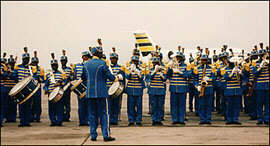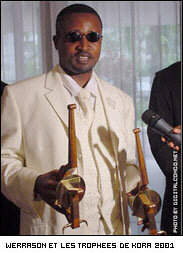 THE CONGOLESE MUSIC THE CONGOLESE MUSIC |

Inseparable from the art of which it was sometimes the extension or the support, the music occupies a selective place in the traditional communities. Anywhere you stop during a walk throughout the Congo, besides tam- tam, a wealthy variety of instruments is displayed such as xylophones, tambours, harps which surround and accompany dancers and singers. Also, musical themes, melodies and rhythms like instruments, vary following ethnic groups and regions.
 Traditional Music and Dances Traditional Music and Dances
In the savannahs of the country, our attention would be principally caught by the music of two peoples. First, the Mangbutues whose orchestral groups have a huge variety of instruments: wood triangular gongs, tambours, rectangular tam- tams, doubled big bells made of iron and ivory trumps extended with leather muffs. Secondly, the Ngbandi, whose sung dances are given a rhythm by the sound of the tam-tam slightly mingled with metal bracelets worn by the"Lenge".
There is no longer anything to demonstrate concerning the choreographic art of Kivu dancers, which has overflowed from Congolese frontiers. Before colonialism, those dancers enjoyed the use of a special education whereby they have been taught their art, history, right, and military art. Now, they are only a group of folkloric dancers we can enjoy in special occasions either in Goma or in Rutshuru at the Mwami.
The musicians are Batwa. The dancers shape a sort of square or they get deployed in two lines. After having executed the opening theme and the greeting dance, they sing the successes of their legendary heroes. After comes the ballet where sometimes both dancers and musicians get mingled. These latter wear either a short skirt, with foliage patterns tissue, or a leopard skin wrapped around their legs, the chest is filled with crossed pearled straps. The head is adorned with a kind of diadem made of monkeys' hair.
Following the region and the theme of the music, the dancers shake an arc, a lance or a stick filled with a tissue of raffia hair. The heels are circled with bells which sound underlines the staccato rhythm of the dance.
The Bapende of Kwilu execute well-known dances: the "Migangi" a dance in which the dancers wear a suit made of multicoloured raffia, a mask and bells round their heels. The "Mbuya" a kind of improvised dance in which the actors wear the traditional mask adapted to the role they play, some of them are covered with leaves and taken up on stilts execute acrobatic dance steps. The "Mungonge" which imitates the undulations of a very big reptile is interpreted by 30 dancers liying on their bellies moving in an Indian queue, the body is almost naked, covered with white painting, women are not allowed to see this dance.
The Mongos' represent a spectacular dance: the "Bobonne" a kind of ballet on several acts throwing different group in competition. The orchestra is composed of various instruments the "bonkwasa", made of bamboo's sticks fit out with an opening decorated of notches scraped with a stick to produce a single-string sound, and the "longer" a great five strings harp taken up on a case of resonance.
The Lundas' dance at the sound of a melodious curbed xylophone, the "Nimba", composed of different wood strings percussed by the musician. Mikishis' dances, at the Tschokwe and the Batatla-Mapsu are also characteristic. In reality the rhythm is present everywhere. The dance that characterises the Lubas' is called the "Mutuashi". |  Kinshasa, the African capital of the sound Kinshasa, the African capital of the sound
The Rhythm? The modern Congolese music has plenty of it. All the African ballets witness so; from Abidjan to Kampala, from Dakar to Addis Abeba, the whole population knows Congolese dances and discs.
It is only in 1947 that they started spreading it out on the market. The pioneers: the Lonpogo, Kansongo, Wendo, Tekele Mo and Kango were, over all, the singers who artistically manipulated the accordion and the guitar. They used to perform on public places, and in particular occasion, such as familiar ceremonies and others.
As a result of urbanisation, the orchestras have quickly move to the pubs: Congo Bar, Masamba, and quist Bar, became the high place of the Kinwa music. Where an orchestra like the King- Jazz conquered his letters of nobility. The 50's record the apparition on the scene of well-woven formations which reputation would not take long to go beyond the frontiers of the country. Among them: the O.K Jazz of Luambo Makimono said Franco, and the African Jazz of Kabasele. Their afro Cuban cha cha cha, will quickly make the Africa tour, and tubes such as "Independence cha cha", "Ambience" and many others marked the 60's while making Franco fortune.
Linking, in an opportune manner, the taste of the rhythm and the lyrics (inspired sometimes by political events, sometimes by classical themes as love "bolingo") with the joy and distress, their creators' shaped a great success throughout an Africa subjugated by the waves of independence.

In the middle of the political whirl bursting on the Congo, the orchestras were delivering a severe competition whereby the great figures of the orchestras' conductors had to burst. Witnesses of the great public adulation, they all have a respectful particle besides their name: "God" Rocherau, "Master" Franco, "Doctor" Nico, "Great" Kale. Titles that astonish Kinshasa's new comers but which are familiar to the Congolese, since they are wholly part of the popular songs and the musicology.
Today, new stars have names as: Papa Wemba, Koffi Olomide, Werrason, Bozi Boziana, Nyoka Longo, Bimi Ombale, Tshala Mwana, Mbilia Bel, Abeti Masikini, Mpongo Love, Ray Lema, JB MPiana etc.
 The Congolese musicians'union: The Congolese musicians'union:
Created in 1972, the Congolese musicians'union counts about 10.000 members, separated into 360 groups of orchestras in the city of Kinshasa alone. One of them has the characteristic of being formed only with feminine citizens: the Taz Bolingo.
In spite of the actual difficulty of the Democratic republic situation, ballets, dancing, discos and private clubs still remain. In Kinshasa, the lines of dancing found in the womb of the Congolese capital give her a particular frame. You should not miss for whatever pretext to make a pop at all the in vogue discos "L'Atmosphère", "Le 36 15", "Le VIP /Saloon", "L'Eclipse", "Le Savanana", and over all "Chez N'Temba" which won't miss to make you enjoy a Congolese rhythm evening.
|

